HistoryAhh, what can be more iconic than Mauser Kar98k rifle?
Produced in over 60 million pieces worldwide it is only surpassed by Kalashnikov AK-47.
Origins of the most famous Mauser rifle are complicated and thus interesting.
In 1888 German Army adopted Gewehr 88, created by a miliary commission. It was a design failure - barrels and chambers exploded, bolts flew back in face of the shooter due to weak construction, hot gases burned faces. Commission, the same that desgined rifle, could not easily explain such a mistake and put blame on manufacturing - factory belonging to Loewe, owner of Mauser.
Meanwhile Mauser worked on his own rifle design. Already in 1887 he got a large contract to supply Turkey - he had to finance factory from a loan received from Loewe who became owner of the factory. In 1889 Mauser sold a new karbine and bullet designs to Belgian governement, making a small revolution in firearms. His design simplified bolt and magazine making them easier in production, stronger and much more practical in the field. License had to be sold to Belgium because Mauser factory was not able to manufacture enough rifles to fill the order. This was beginning of Fabrique National (FN).
In 1898 Mauser got a contract from German Army for Gewehr 98 - the latest improved version of his rifle. A year later he developed a shorter version (435mm vs 700mm) called Karabiner 98.
Meanwhile German Empire lost World War I and had to pay reparations to winning countries. Not only rifles from storage, but also whole weapon factories changed hands - for example in 1921 factory from Danzig was awarded to Poland and used to establish rifle factories in Warsaw and in Radom. This explains why Kar98/A/AZ/b and locally improved variants were used by so many countries.
By 1924 Mauser Kar98 has evolved through several variants (Kar98A, AZ, b) and became Kar98k, "kurz" = "short". Interestingly it first became a standard rifle for... German Post! In 1935 Adolf Hitler renounced demilitarisation of Germany and Kar98k became the standard rifle of the Army.
Kar98k was modified in 1939, 1942 and 1944, keeping the designation. Versions starting from 1943/44 were called "Kriegsmodell", wartime model. Reason for ongoing modifications was simplification and ramping up production to keep up with WWII requirements. The final version from 1945 was called Kar98kv, "vereinfacht" = simplified.
After the war Mauser 98 rifles were used for hunting and for sporting purposes, with further millions manufactured. There are estimates that Mauser 98 (including all military, hunting and sport variants) could have reached as many pieces as AK-47.
Variants of Gew98/Kar98 can be dinstinguished by design and size changes, you should be able to dig out this information from various online resources.
Another interesting subject is the bullet that Mauser 98k used. Depending on source you can see it described as 7.9, 7.92 or 8mm. Germany copied French smokeless 7.92mm cartridge and called it 88J: model 1888, for Infantry use (letter J was used instead of I to avoid confusion with number 1). Barrel caliber was 7.84/7.92mm (land/groove), so 7.92mm was used as the official caliber to distinguish it from French 8mm (for the same caliber). Later on official German designation was changed to 7.9mm. Barrel has changed too, because now 7.9mm was measured between lands, while grooves were 8.23mm apart! A new bullet was therefore designed, longer than the old one to prevent loading it in older rifles - there was a period of confusion as the rifles were converted. Ammo for civilian use in Mauser rifle had 8mm designation.
Wikipedia information about Mauser Karabiner 98k:
http://en.wikipedia.org/wiki/Karabiner_98kExcellent page in English, French and Polish:
http://mauser98k.internetdsl.pl/indexen.htmlThis is one is in French only, but it has a lot of pictures
http://tirmilitairefabrice.ifrance.com/site%20mauser1/Mauser.htmAnother page with information:
http://world.guns.ru/rifle/rfl02-e.htmModelgunMauser 98 very quickly became available as a modelgun.
CMC (Colt Model Collection) was one of the first modelgun manufacturers, specialising in metal models. Mauser Kar98k variant was choosen, and it was designed in late 1960s by Minoru Matsumoto (who later founded Shoei) who also manufactured metal parts in his company "Matsumoto Seisakusho". Molds were created by him, and after the initial production runs ownership transferred to CMC. Wooden parts for the stock were manufactured by Tanaka Works. Everything was assembled, packaged, marketed and sold under CMC trademark.
When CMC ceased operations, Tanaka bought the molds and continued production of Kar98k for a brief time.
The last batch of Kar98k was released in 2007 by CAW (Craft Apple Works), who had close ties with Tanaka. They have taken unused inventory parts (zinc and wood) from Tanaka, manufactured remaining steel parts and assembled everything together. CAW also released a Gew98B variant. Only 150 pieces of Gew98B, 60 pieces of Kar98k and unknown number of Sporter models were released, Kar98k is currently sold out.
http://www.caw.co.jp/caw/mauser/index.htmlKar98k is the most known model, a shorter version of original Gewehr and also of original Kar98. CMC has choosen to replicate war-time variant from 1942, Tanaka released it as 1943 version.
Gew98B is virtually the same as the longer rifle: Gewehr 98, produced after WWI with several small modifications. It was called Kar98B because Treaty of Versailles allowed Germany to produce only short carbines - they produced a rifle under "carbine" name to step around the law. Modelgun is virtually the same as Kar98k, but features a longer barrel and also longer woodwork. Tanaka choosen to replicate 1917 model here.
Sporter is a civilian version, with differently shaped, shorter wooden stock and a nickel bolt, plus some other changes.
Second-hand models are frequently available from a variety of sources.
I think that the only accessory for modelgun was an optical sight released by Tanaka. It was called ZF41, but was nothing like the real ZF41.
Other than modelgun accessories, a lot of real Mauser 98 series parts are available from many sources. I have not checked which ones fit modelgun though.
NOTE: because there were many variations of real Mauser 98 series rifles, if you plan to buy a real part or accessory, first make sure this is at least for correct type of rifle! Many times sellers say only "Mauser 98" or "98k", but such part might not be appropriate for Kar98k!Rifle wz29, based on Mauser 98, was a standard rifle of Polish Army during WWII. This is one of reasons why Kar98k is so interesting for me. I really wanted to have one, especially as this is one of a very few bolt-action modelguns.
After saving enough money I could finally afford a second-hand CMC Mauser Karabiner 98k.
Modelgun information (mainly in Japanese):
http://homepage3.nifty.com/nkoinuma/WW2G.htmMauser Sporter version (in Japanese):
http://gfc.air-nifty.com/blog/2008/01/cmc_mauser_kara.htmlBoxMine arrived without the original box, but you can find pictures on the web. CMC used a cardboard box, with a logo of German Eagle and several texts on the top: "World War II", "Mauser Karabiner 98k Kal 7.92mm", "Military Model & Sporting Model" and "MFG Tokyo CMC". Inside, on styrofoam inserts, you should find the rifle itself, with a sling, 5 cartridges in a clip and instructions.
My copy of instructions has four pages: title page, basic disassembly (with pictures), exploded diagram and company information. It's not much, even with pictures, so you should get a manual for a real Mauser rifle - model is very close to it.
ModelgunIt takes some time to stop saying "wow!" ;-)
CMC Kar98k is a beautiful model, you can easily see why CMC had the reputation to produce the most realistic modelguns. Fortunately Shoei (original manufacturer of metal parts) continues this tradition with their dummy models.
At the first sight is is difficult to see that it is a modelgun. Models of long arms are allowed to be painted black, so all Kar98k metal parts are black. Finish quality is very good, with well-defined (but not sharp) edges. Wooden stock is beautiful, all parts go together just right.
Rifle is quite large, even if it is the shortest version of Mauser 98 rifle. Being used to pistols and submachine guns, rifle is a nice change and a completely new experience! This model is very solid (although please see note below) and nicely heavy. Weight is just under 4kg, like a real rifle. When working on rifle design Mauser promised that it will weigh under 4kg.
 Stock
StockStock is wooden. Real rifles had wooden stocks for a long time, but in 1939 migration to plywood stocks has started - they were cheaper to produce. Migration was completed around 1942, so modelgun is ok in this respect.

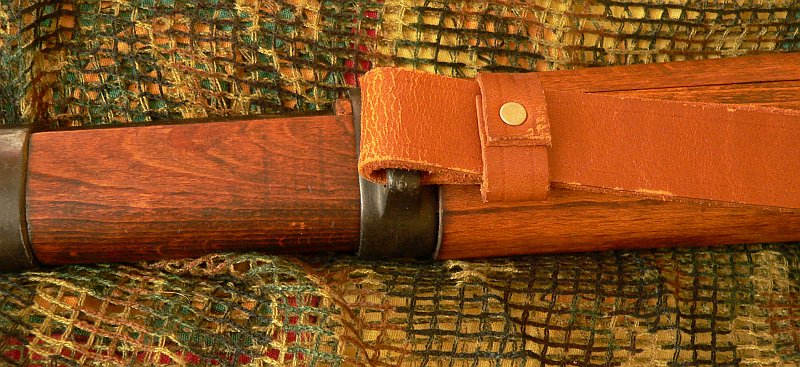
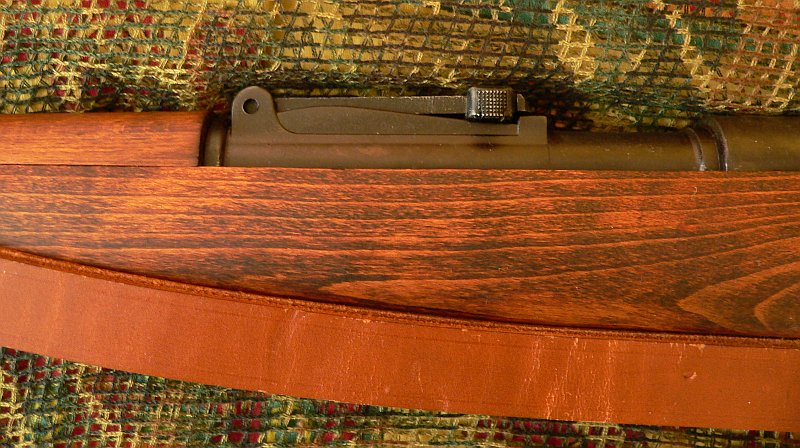

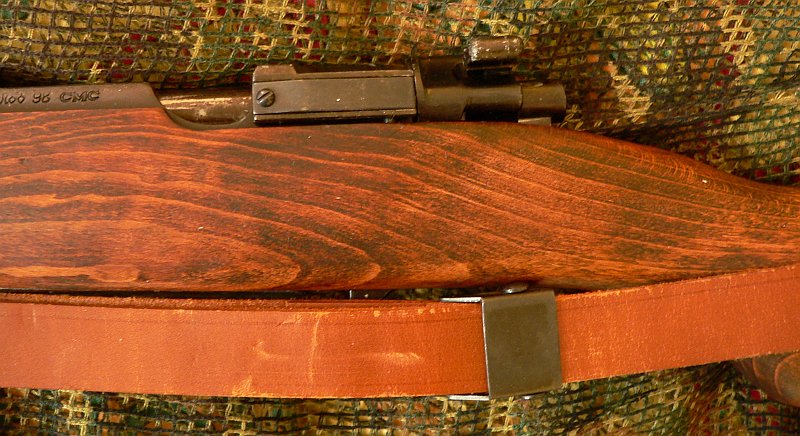
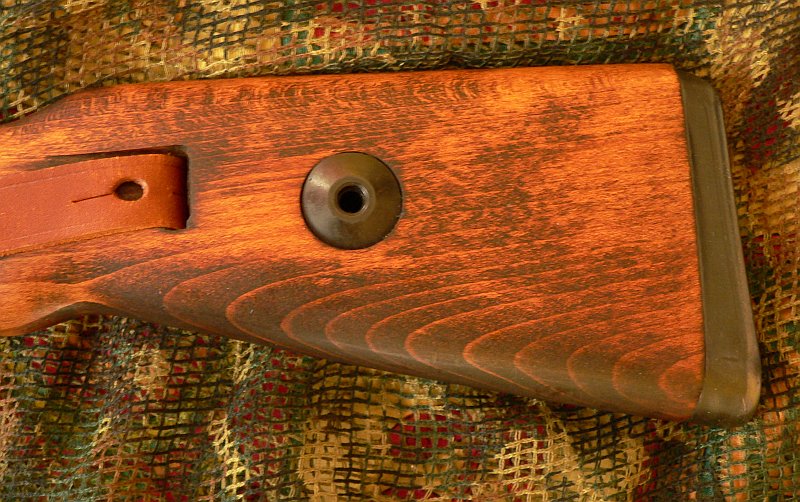

Stock itself is composed of three pieces. The main one extends through almost all length of the model, from the butt, under all mechanisms and most of the barrel, until about 25cm from the end of the barrel. A smaller, 25cm handugard piece covers barrel from the top, starting behind the sight. It was put in place to allow soldiers holding rifle even when barrel is very hot. These two pieces of wood are held together by a metal ring. The third piece of handguard wood fits under the barrel, into the same metal ring and extends towards the front, terminated by another metal piece with an integral bayonet lug and cleaning rod. These pieces are held together by a flat spring that goes on the right side, under the metal ring and metal part.


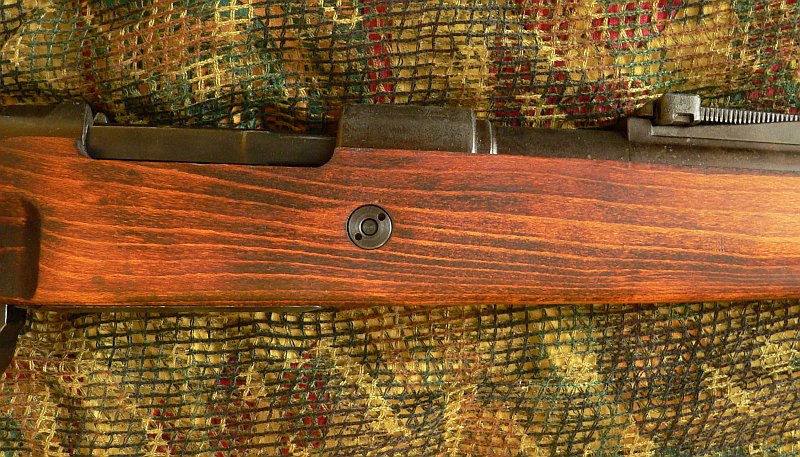
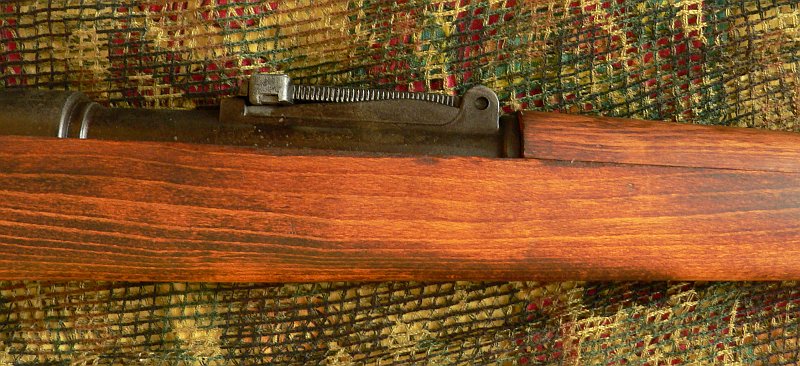
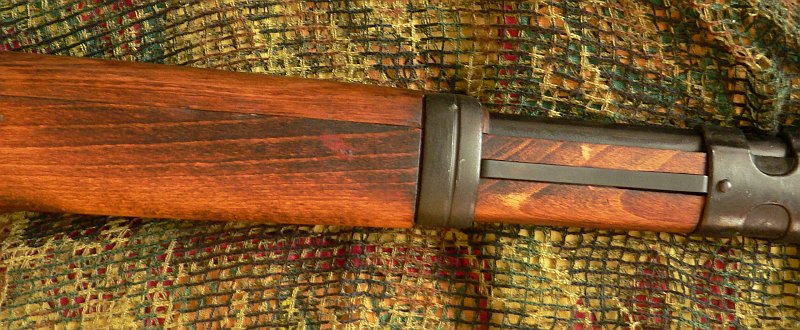

Metal part with bayonet lug is not held stiffly in place, it moves around a bit. If a bayonet were mounted, it would probably not withstand hits. This is a similar fault to an original Kar98k. While full-size Gewehr 98 had a large bayonet lug that was meant to be used and abused, Karabiner 98k had a very short lug that could give way when bayonet hit bone or other hard surface. It was just not meant to be used for close fighting like in the old times.
Modelgun piece is also different from a real one from this period. Originals between 1939 and 1942 looked H-shaped from the side, with holes cut in them. Actual bayonet mounting went inside. Model only has a partial hole on the top part and it is made a single piece. What's more, starting from 1942 this part was straight, without H-shape, so it's not that accurate. Because modelgun part is a single piece, it is not easily removeable from the barrel - it does not fit over the front sight.
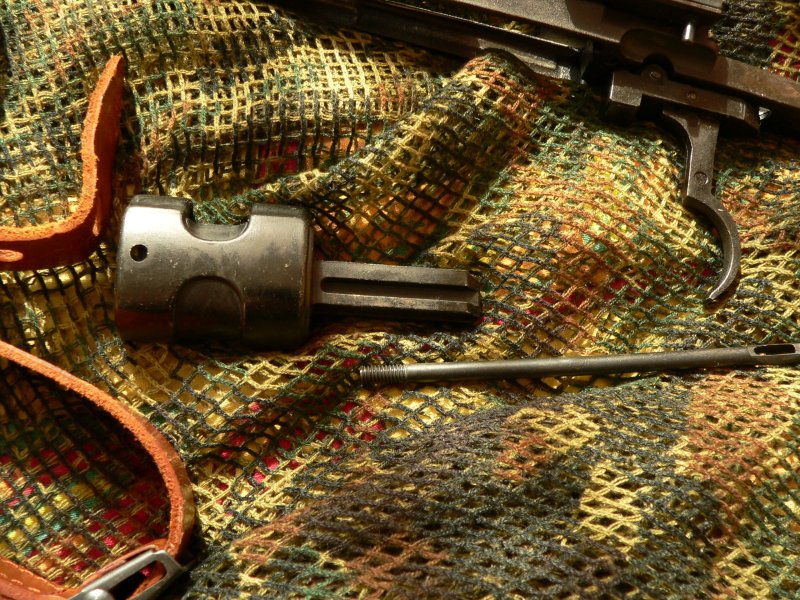
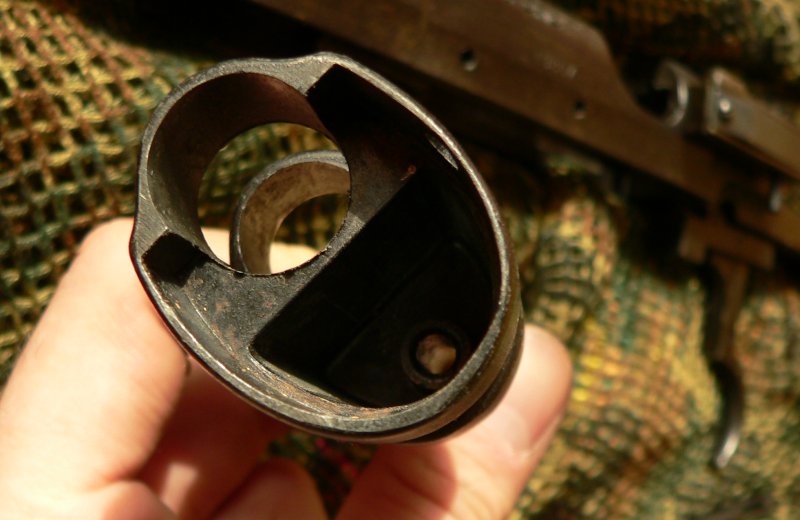
Cleaning rod in modelgun version is just a short (15cm) piece of metal that is screwed into the metal piece. It cannot be realistically used for any cleaning, and there is no provision to put a longer cleaning rod that would hide below the barrel.
Suprisingly, real rifles partially share this feature! When Gewehr 98 was designed, Mauser decided to save weight and included only a short, 33cm piece of cleaning rod with each rifle. Two (for carbine) or three (for rifle) such rods could be then screwed together, making a proper cleaning rod. Given that all rifles were cleaned together, on schedule, it was a good idea. Using short piece not only saved weight, but also standardized this part (everyone had the same piece, regardless of rifle length), simplified provisioning and avoided mistakes of using wrong rod lenght.
After WWI Germany did not officially have an Army and it was no longer possible to clean rifles in the same way as previously - now every soldier had to clean it whenever he had time, individually. For that purpose a cleaning chain was supplied (as part of rifle toolbox). Cleaning rod was made even shorter, and it was only used (staying in place under barrel) to put together three rifles and make them stand upright to avoid dirt.
Left side of the metal ring has a loop for attaching the sling. The other side of the sling goes through a hole in butt of the stock, and is held there by a "Frog" (specially shaped piece of leather) on the right side. Original sling was made of leather, with a black, metal buckle. Model sling is made of leather, but probably of lower quality (or long storage deteriorated it) - it is stiff and starts to crack on the surface in places where it had to be bent.

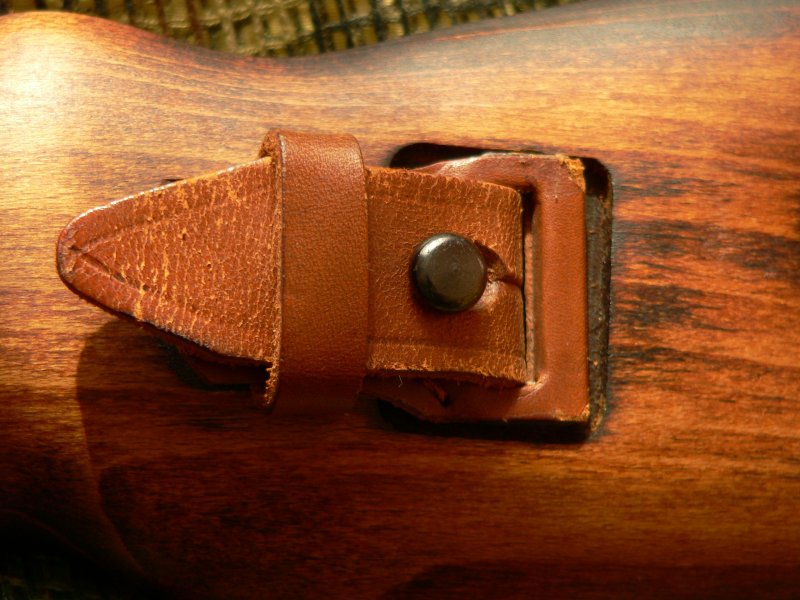
Just behind the hole for sling, stock has another hole, with metal edges. It is used for disassembly of the bolt in the field - at a certain point you need to compress bolt spring to disassemble it further, and this strenghtened hole serves just this purpose. This hole was eliminated from the late-war models (around 1944) to save on cost and time of manufacturing - another hole in the metal butt plate was used for that purpose.
Below the chamber there is a metal screw that goes through the stock. In real Kar98k it reinforced the stock, in modelgun it is purely for decoration - you do not need to remove it even for disassembly.
Back of the stock features a metal butt. In earlier versions of this rifle it was a thin sheet metal, but Kar98k has a deeper piece that reinforces the stock. It is held in place by two screws. There is a stamped logo: German Eagle with swastika, and "CMC" underneath. Tanaka version kept "CMC" name, but the last CAW release had it drilled out of metal.
Modelgun stock is also stamped on the right side behind the holes with a Waffenamt code (inspection proof). CMC has choosen "WaA79" code that does not correspond to any real factory. The same stamp was used by Tanaka, while CAW did not stamp the stock as far as I know.
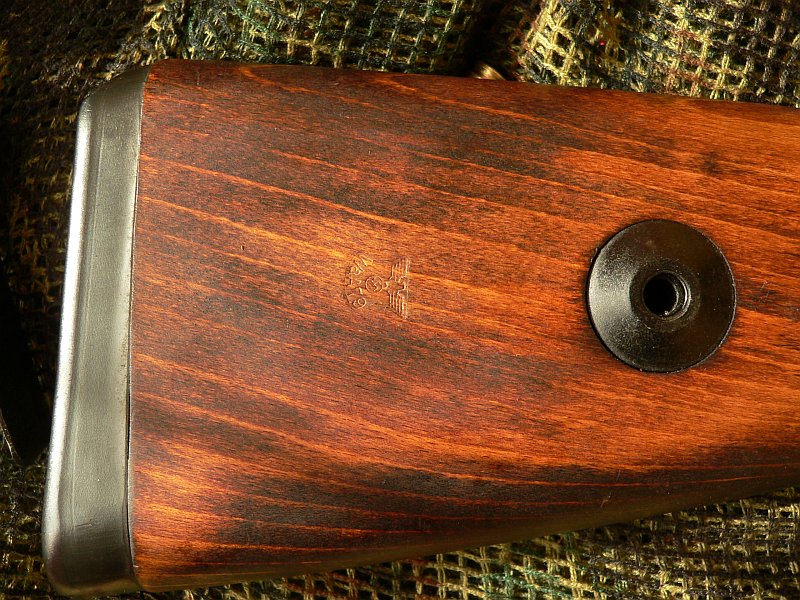
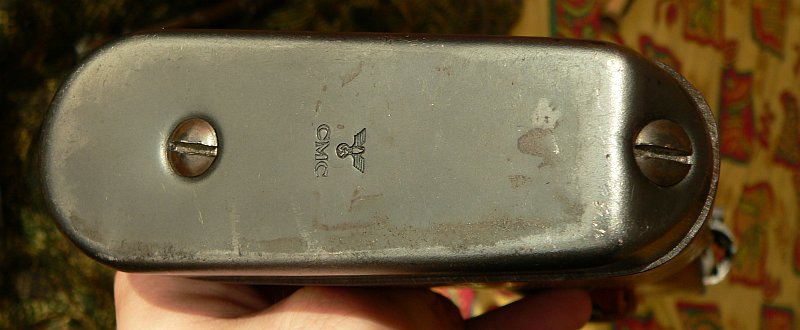 Sights
SightsFront sight is a single blade, enclosed in a metal sleeve. Blade is fixed in modelgun, while in a real Kar98k you could adjust it by shifting sideways. Sleeve was introduced in real Kar98k in 1939. Previously there were protective "ears" on the sides, with a hole in them to allow adjusting the sight.
Slope of the sight towards the shooter is grooved. Original sight was initially criss-crossed to reduce light reflections, but when sleeve was added in 1939 it was changed to a grooved version.
Back sight is a tangent sight. You can push a button on the sight and move a metal part making the arm raise. Scale goes from 100m ("1") to 2000m ("20"). This is the same type of sight that was used on real Kar98k. Gewehr 98 initially used a much larger, heavier, curved sight called "Lange Visier", enforced politically by the Army. Starting from Kar98AZ model it was replaced with tangent sights that had the minimum distance lowered to 100m from previous 400m.
Sight is marked only on upper surface. Original sights were marked on upper/lower surface until 1942, later only on upper - like in modelgun.

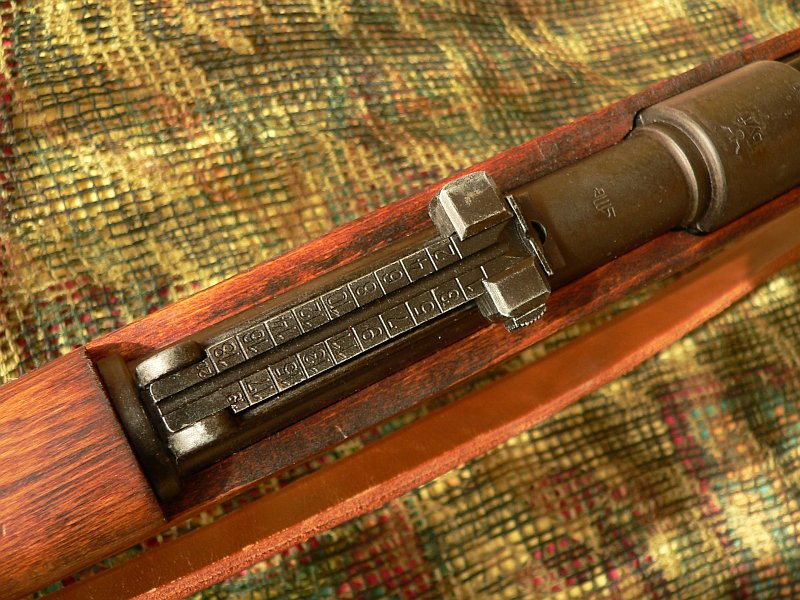
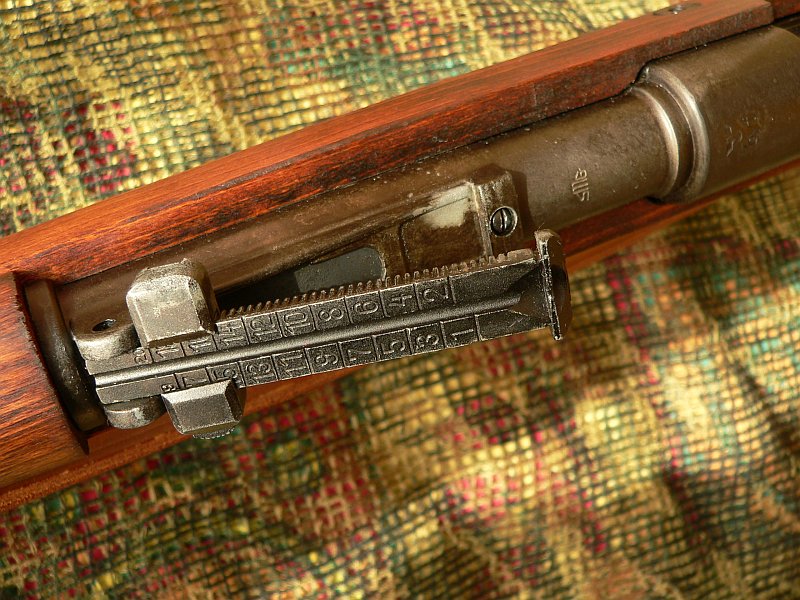 Magazine and trigger
Magazine and triggerMagazine is another masterpiece of Mauser.
Historically there were two main requirements for a good rifle magazine: being able to add cartridges before magazine is empty, and placing magazine in rifle's center of gravity.
Central placement did not change balance of the rifle as magazine was emptied, and allowed for more accurate shooting.
Magazine was fixed and closed, so dirt did not get inside - older designs had to have a hole in bottom so that clip (the only thing that held cartridges in position inside) could fall out when it was empty. Mauser did not require clip to stay inside the magazine, it was removed during loading. It wasn't until M1 that Garand solved this problem in a different way - there was no hole, clip stayed inside magazine, but after emptying it was automaticall ejected through the same hole as spent shells (PING!).
CMC Kar98k has a double-column, 5-cartridge magazine, just like the original. Mag follower is solid, corresponding to the real one from that period. Later versions were made from stamped sheet metal. Follower is pushed by a flat spring.
The first Mauser design had a single column. It worked well, but magazine stuck out of the bottom of the rifle, and it had mechanical parts to prevent double-feeding. Improved version had two columns and fit completely inside the stock. Double-feeding was prevented by the way cartridges align in the mag - only the topmost gets picked up by the bolt, the next one is held below by magazine lips.
There was also a rarer 20-cartridge version of magazine ("Grabenmagazin") used in Gewehr 98 during WWI, not seen later on.
Another Mauser feature present in modelgun is a removeable bottom plate of the magazine. This allowed quick unloading when necessary for maintenance. Soldier only had to press a button at the back of the plate, near trigger guard (using a bullet, or a special tool) and shift the plate slightly to get it off the rifle (warning: spring inside). Versions from the final stages of WWII had a fixed plate that could not be removed.

When magazine is empty and bolt opened, the follower will interfere with bolt face and stop it from closing. This lets user know that the magazine is empty - just like with modern pistols and submachine guns. To close the bolt either load cartridges, or just press follower down with your finger and close the bolt.
At the bottom of the rifle, behind magazine plate you will find trigger guard and inside trigger guard there is a trigger ;-) Pull is quite short, easy, does not require much force.
Whole trigger mechanism is held to the stock using two screws: one right behind trigger guard, another one to the front of magazine plate. Front screw is secured with a guard screw to prevent accidental unscrewing.
 Main body
Main bodyMain metal body of the model is sitting inside the wooden stock, with the top part available for the operation. Starting behind the top wooden guard there is the back sight (discussed above), then the end section of the barrel with "SMG" stamp. Area over the chamber has more marks: German Eagle with swastika and correct factory code: "byf". This corresponds to the main Mauser factory in Oberndorf. There is also "1942" date, which is probably incorrect marking - real rifle would have just the last two digits "42" in that case, although other factories used 4-digit year. Left side is marked "Mod 98" written in Gothic, and "CMC" in CMC font. Original rifles had "Mod.98" marks there.
Under the wood stock there is a serial number, as well as two holes for mounting a scope.


Tanaka version was marked differently: "bnz" factory code (Steyr-Daimler-Puch), "43" year code (correctly in this case), as well as inspection marks on left side "WaA77" (together with "bnz" this is correct for Steyr-Daimler-Puch) and 4-digit serial number (not sure if unique). "CMC" disappeared from the side. All markings are painted in white - I am not sure if this is 100% correct because originally some factories used stamping, others white paint.
CAW release is marked as Tanaka, but with stamped, not painted markings.
Main body is composed of two parts, frame and barrel, that should be firmly attached together.
Barrel is only held by friction, it is pushed into the frame. There is an antirotation lug, but that's all.
I found that in my model barrel was a bit wobbly in up/down direction, but still held in place.
See "Problems" section for more information.
Right above the magazine there is a large ejection port, opening whole top and right side. There is also a smaller cutout on the left side. If cartridge case failed, this was used as an exit path for hot gases to avoid them hitting face of the shooter (problem of Gewehr 88 design).
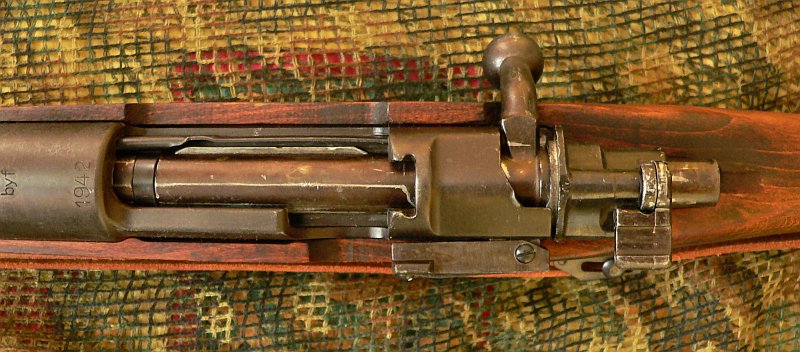
Cartridges are loaded from the top (bolt open of course), clip enters lips just behind the port and cartridges are pushed down into the magazine. Clip is removed upwards, after locking the bolt rifle is ready to shoot.


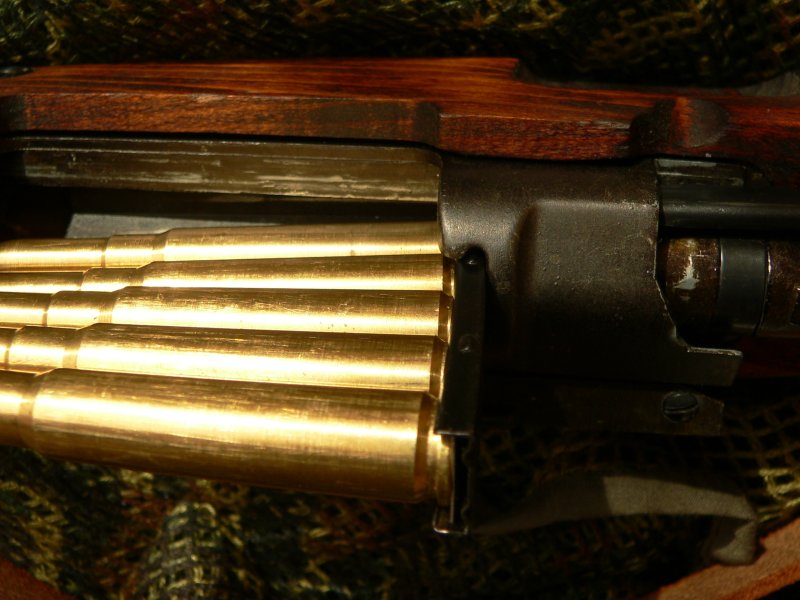


Bridge over the bolt is short - front side has cutout for inserting the clip, back side another cutout where the bolt handle travels during un/locking. Left side of the bridge contains bolt-stop with ejector, mounted using a screw to the bridge. This part is normally closed, ejector sits inside and launches empty shells to the right. You can open this part - just pull to the left, against pressure of a spring leaf. Now bolt stop and ejector are removed from the path of the bolt and you can remove bolt itself from the rifle.
Behind the bridge, at the bottom you can see trigger sear - when you pull trigger this will release striker and fire the rifle.
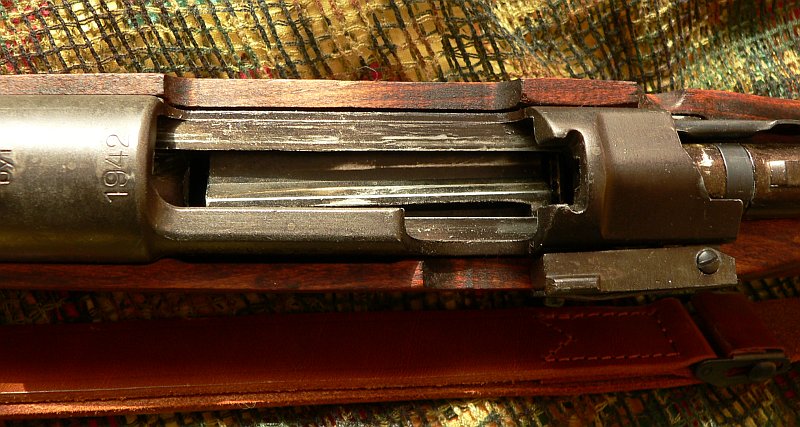
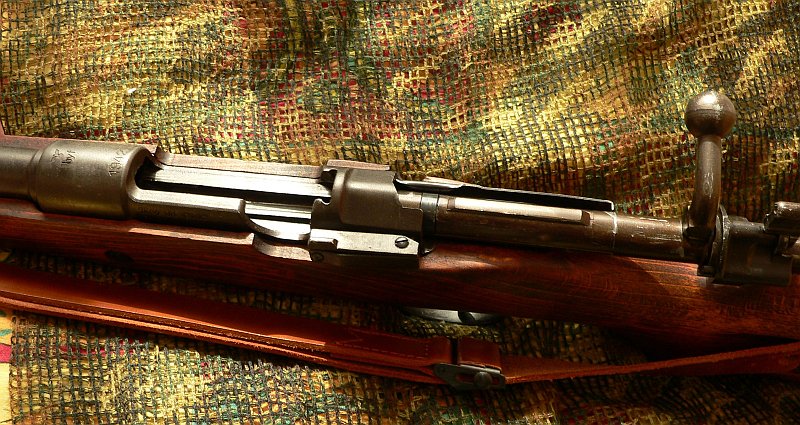


Modelgun chamber contains detonator pin, of course :-) It's placed deep in the chamber - cartridge is almost 6cm long.
BoltBolt - the central piece of the rifle. It is surprising how simple it looks compared to how many functions and features it has.
Bolt picks up a cartridge from the magazine, pushes it into chamber, locks itself against cartridge pressure, later extracts empty shell from the chamber and ejects it. In the meantime it has to set up firing pin. Safety is an integral feature of the bolt, too. Let's look at all these features in more details.
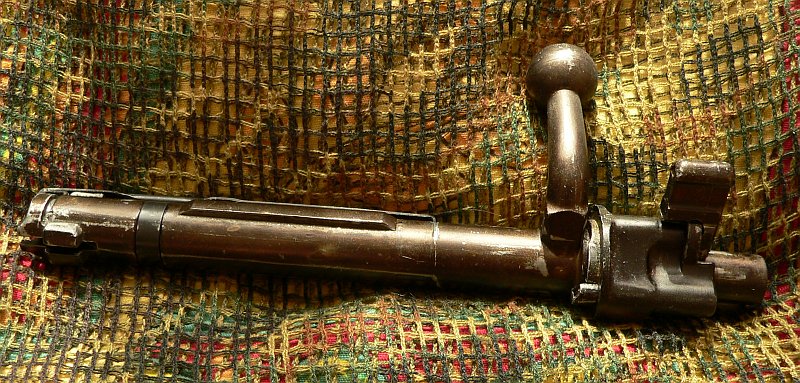
Older bolt designs consisted of two or three pieces, while Mauser designed a single-piece bolt (main body is a single piece, but it has other small moving pieces).
Instead of using the handle as the main lock, this bolt has two locking lugs on the front face, plus another one further back that was a backup in case one of main lugs broke off. Such design allowed to increase pressure in the chamber, and therefore power of the bullet. Modelgun has only two main lugs, the backup lug is missing from its bolt.
Next innovations was extractor claw. In previous designs it was fixed to the bolt and rotated when bolt was locked/unlocked. Friction between extractor claw and cartridge shell required more force than Mauser design, where the extractor stayed in place while bolt rotated, thanks to the way it is attached on a rotating ring. Extractor is also used as a guide for the bolt.
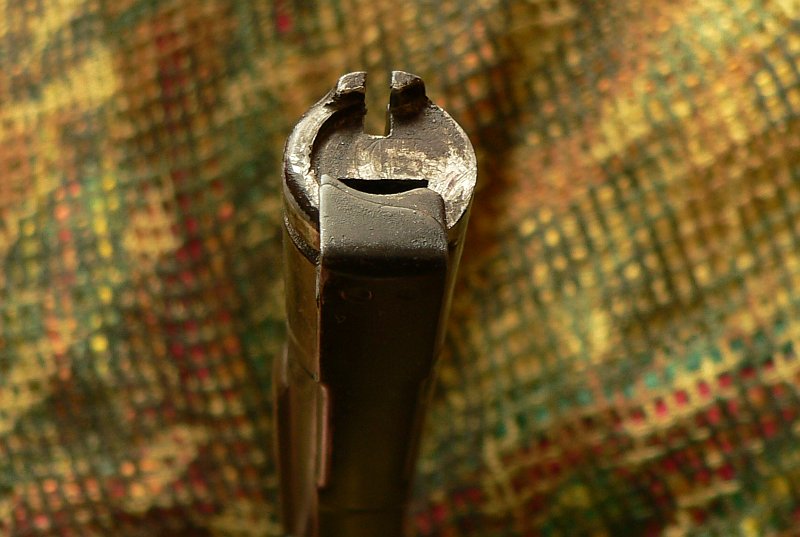
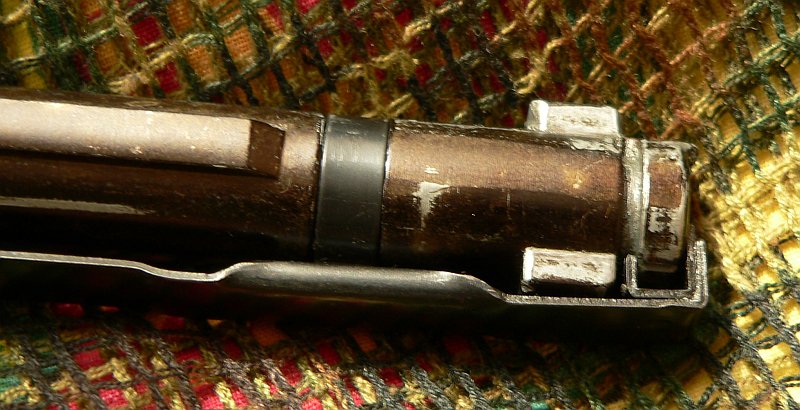
Bolt holds tightly back of the cartridge from the moment it leaves magazine, until shell is ejected. This is a controlled feed.

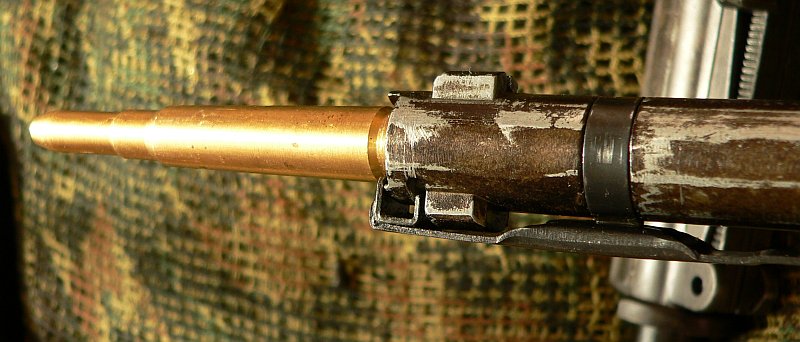
Bolt handle is an integral part of the bolt, not screwed on or attached in other way. Initial Mauser designs had a straight handle, later (Kar98AZ) design was changed to an angled handle, making it stick out less and operation easier. Gewehr 98 had a straight handle with a round ball at the end, Kar98AZ introduced a cut-off ball with knurling (same as in Sporter version), finally Kar98k has an angled handle with a round ball.
Length of the bolt was also decreased. Older bolts armed firing pin during the first (unlock) or third (close) bolt movement, requiring relatively large force. Mauser bolt does it in two parts, half on the first (unlock) and half on the fourth (lock) movement = less force. This has an additional bonus: in case of misfire, all you need to arm firing pin again is to move bolt lever up and back down, without extracting the cartridge. Previous designs required manual manipulation of the back part of the bolt to achieve that. Mauser could therefore make the bolt shorter - it did not require these extra mechanism.
When firing pin is armed, the back of the bolt sticks out and you can immediately (if you know about this feature) tell if rifle is cocked or not.

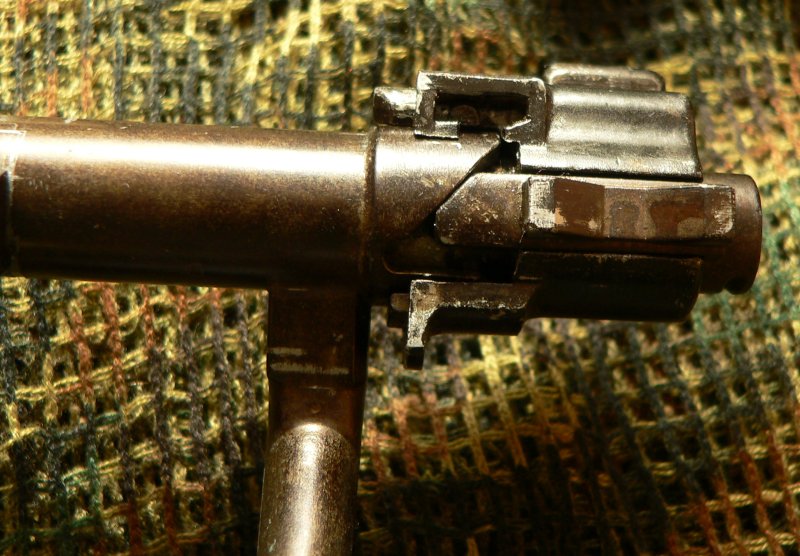
Modelgun bolt replicates all these features, except that firing pin is not central, but in half-moon shape, shifted to the side of the bolt. It is still a center-fire system, because firing pin pushes core of the cartridge forward, against detonator pin. Cartridge body is left in place, unlike side-fire models. Extractor works just like in a real rifle, you can also arm firing pin by up/down movement of the lever - try it!
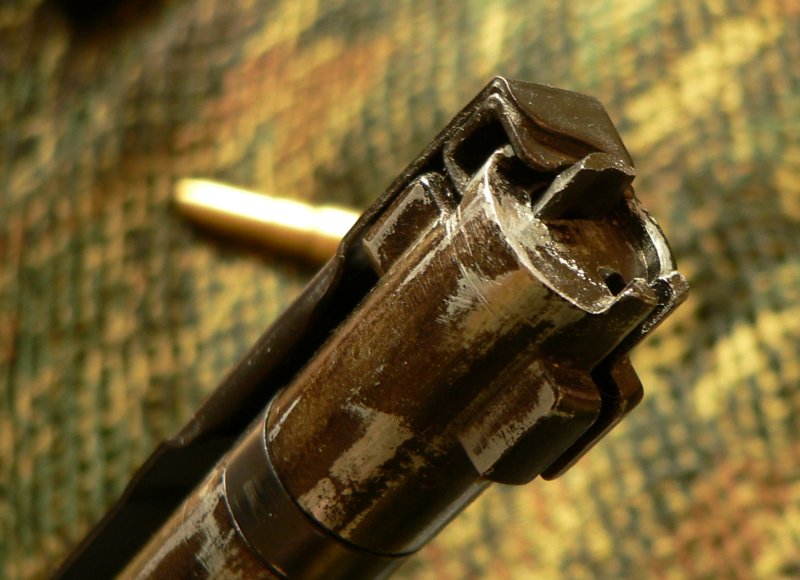
Of course Mauser bolt is not ideal. It did not allow fast operation and required hand to move more than for example compared to Lee-Enfield. Still, it is a very good design.
One feature of a real bolt that is not replicated in modelgun are two oval holes that were used (in case of a shell rupture) to redirect hot gases from bolt base towards the cutout in the left side of the rifle. Modelgun still has a gas shield around the bolt just behind cocking handle - yet another feature to prevent being hit by hot gases if shell ruptures.
Modelgun, just like original Mauser rifle, is equipped with an interesting safety mechanism. There is a wing at the end of the bolt that can be rotated when the firing pin is armed (it does not rotate when it is not cocked!). Normally (fire) it is in leftmost position. If you rotate the wing to upwards or to the right position, rifle (or modelgun) is in safe position - you can press the trigger, but firing pin will not be activated.
Why two "safe" positions? In the upper position, bolt can be still unlocked and operated normally. Thanks to safety wing that obscures sights user should not confuse this with "fire" position. Rightmost position additionally blocks bolt in locked position - bolt andle cannot be rotated.
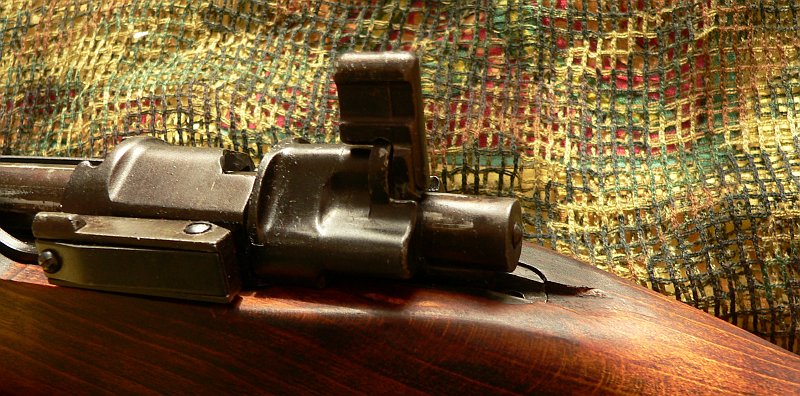
 Cartridges
CartridgesMauser rifles used a variety of cartridges, designed as 7.92mm, 7mm and 8mm but with varying parameters.
Apart from live cartridges, there was also a training, dummy version of the cartridge (Exerzier Patrone), and a blank version used for launching grenades. If you are interested in variants, check this directory:
http://home.scarlet.be/p.colmant/792color.htmModelgun was originally released by CMC with two-piece cartridges made. Main body was made of brass, inside there was an aluminium insert going through whole length of the cartridge. They are open type - firing pin in the chamber strikes the cap directly. Cartridges use a single 5mm cap. You need to push the cap inside by a few milimeters, so that the bottom of the cartridge is flush with the edge. To remove cap after firing, just push on the bottom of the cart.
Remember to disassemble cartridges for cleaning - push from the top, then grab bottom and pull it out carefully. Clean both parts, taking care not to damage the o-ring. Use silicone on o-ring before putting both parts back together.
Tanaka released their own, more realistic cartridges, where the main brass body had a copper-coloured head.
CAW came back to original CMC design.
Note: you cannot cycle dummy or deactivated cartridges in modelgun - detonator pin in chamber interferes with bullet tip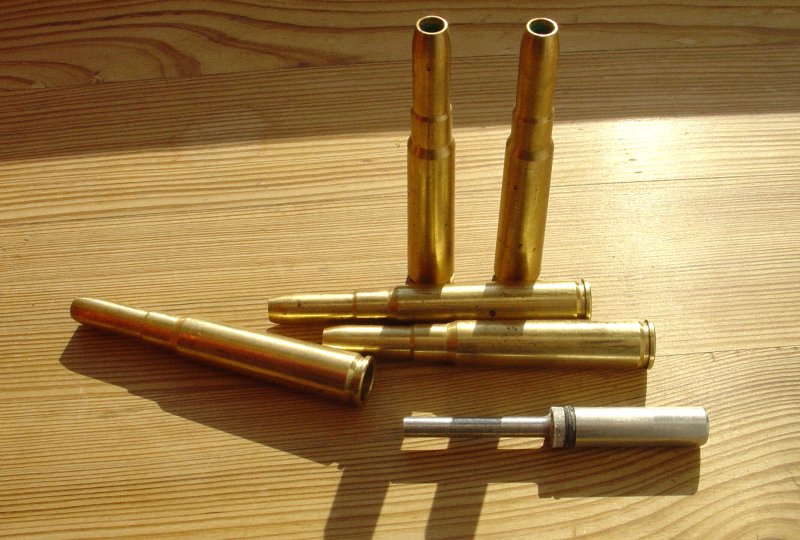
 Firing
FiringIt's fairly simple - pull the bolt back, insert clip with 5 cartridges into the slot, push all cartridges into the magazine, remove clip. This might require some practice. You can also load cartridges by hand, individually.
Lock the bolt, aim, fire!
The best part comes after the shot - unlock the bolt, pull the handle, observe cartridge flying out. That's what is so cool about bolt-action rifles :-)
Note: cartridge is large and heavy, it can inflict damage on surroundings!Due to Japanese regulations there is no straight path from the chamber to the barrel, but there is a gas bypass, rerouting smoke around the blockage and into the barrel. Barrel is quite long, however, so not much smoke escapes there.
ProblemsThis is a very solid modelgun, with just one real problem.
As mentioned earlier, barrel pushed in place and held to frame only by friction.
Even if barrel is in place, it had a noticeable up/down play.
Trying to correct the situation I have disassembled whole replica and pulled out the barrel.
In part this was a mistake, because when it was pushed back there was not enough friction to hold the barrel in place any longer.
I considered using glue or other solutions, but ended up with the simplest one: a shim.
Drank can of beer, cut out a small strip of aluminium, placed it on top of the barrel and pushed back inside.
Now the barrel is not only held in place, but also does not wobble anymore.
Unless you absolutely MUST, do NOT remove barrel from the frame. Eventual wobble should be rather fixed by pushing a shim into the gap without removing anything.
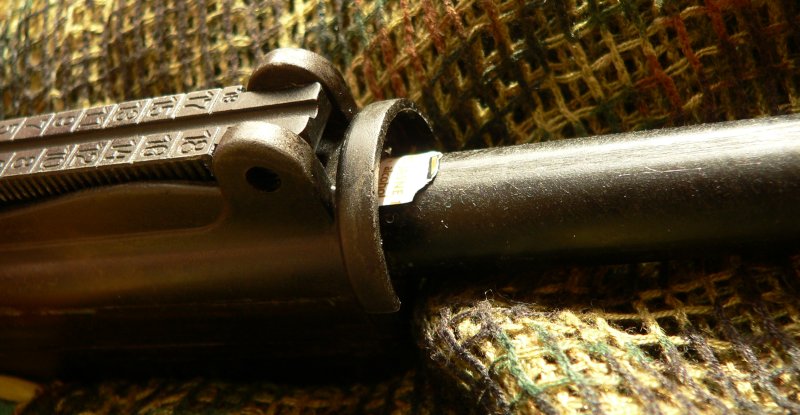
Other than that only a few comments:
- when magazine is fully loaded, the first cartridge sometimes blocks against chamber insted of entering it correctly. Using more force you can push bolt and chamber the cartridge, but over the time stress might damage it as well as chamber area (which already has scratches and marks). I am not sure what causes this problem.
- the last cartridge in the magazine sits too high and does not get under extractor claw. It is pushed by the extractor claw itself (instead of bolt face) and gets left in the chamber instead of extracting when the bolt goes back. Rim of the last cartridge gets too high because it does not sit firmly in the magazine. Middle of cartridge is held between follower and frame, so it pivots on this axis. Depending on how the cartridge ends up you either get a correct operation, or cartridge stuck in the chamber (plus damage to extractor). This might be fixed by either modifying extractor claw (dremel off a bit from the bottom) at the expense of controlled feeding, or by modifying mag follower to ensure correct position of the last cartridge. I plan to get both extractor and mag follower from surplus and work further on them.
- bridge gets slowly damaged where it is hit by bolt handle on the first, unlocking move upwards. This is expected due to construction of modelguns - softer zinc alloy is used for main body, while bolt is made of steel.
- initially caps did not detonate. I found that firing pin in the chamber was screwed in too deep. Simple adjustment was enough to make rifle work. This rifle uses 5mm caps that seem (at least mine) to be less reliable than 7mm, but even in case of non-fire you can just move handle up/down cocking the model and shoot again. All caps eventually worked.
Pictures show: first cartridged gripped correctly, blocking in chamber, last cartridge does not fit under extractor claw.
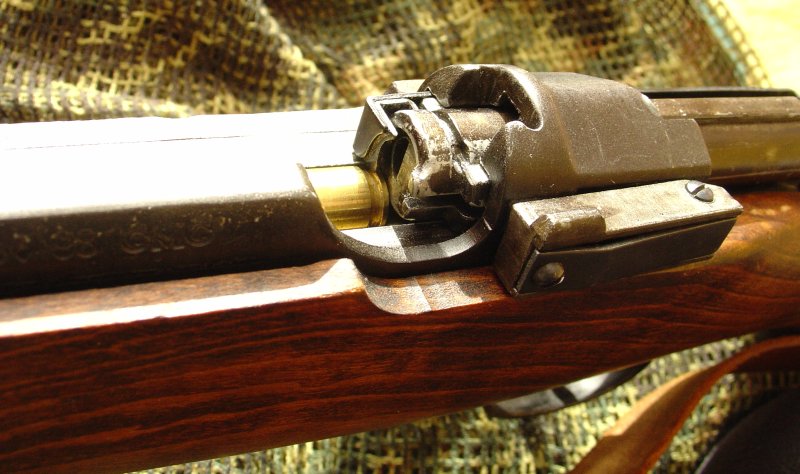
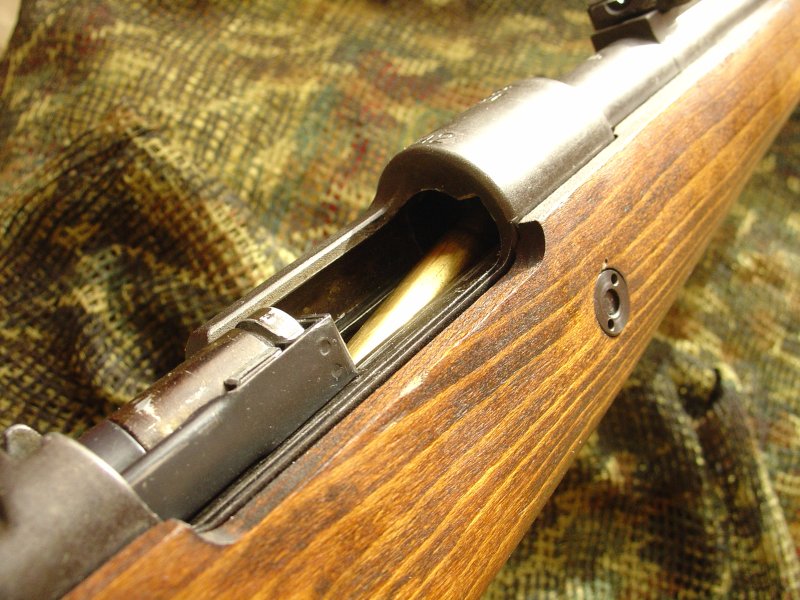
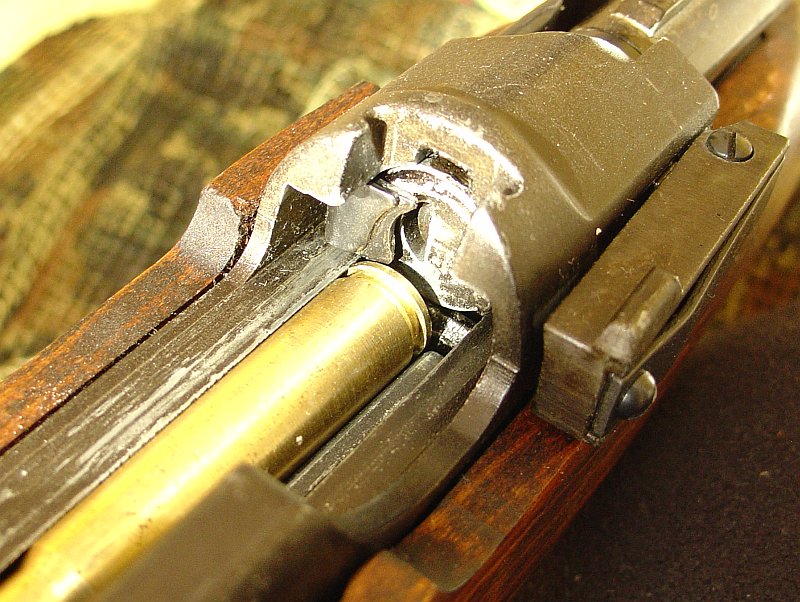 Basic disassembly
Basic disassemblyDue to size disassembly instructions have been posted separately in another thread:
https://mp40modelguns.forumotion.net/modelgun-stripping-and-rebuild-guides-f12/cmc-mauser-kar98k-complete-disassembly-t2190.htmOverallI can definitely recommend CMC Kar98k modelgun :-)
As an bolt-action rifle it is a refreshing change from the usual models.
Very solid design, all metal and wood, high quality, good action (even if with small glitches) - that's what is expected from a modelgun.
